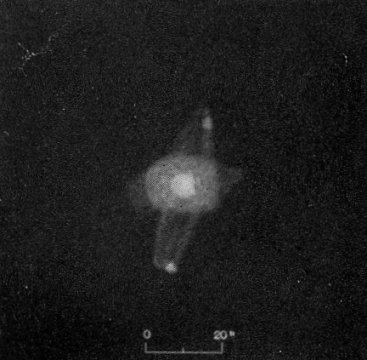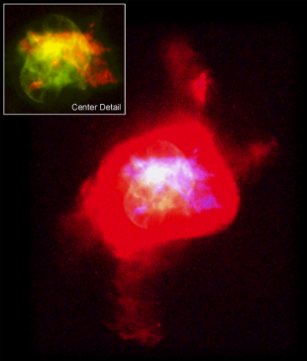NGC 6210
"Central star...surrounded by bright matter in the form of an
oblong 8" [seconds of arc] in length. Outside of this is
an oblong of somewhat fainter matter 20" X 13", from the ends of
which extend two fainter ansae...From the north and south sides of
the central oblong extend two longer ansae...making the nebula 43"
long..." says Curtis, who describes both his composite drawing
(left) of this bizarre nebula AND the Hubble image (right) quite
well indeed. Many planetary
nebulae, NGC 6543, NGC 7009 among them, exhibit opposing bipolar
flows or jets that emerge from the central source, perhaps as a
result of stellar rotation or duplicity. Here we see
not one set, but quite distinctly TWO of them that are so bright
that Curtis saw both. (Something similar is seen in IC 4593.) No one knows what makes the
bizarre form, which has been described as "a turtle swallowing a
seashell" [Hubble].
In Hercules, four degrees northeast of
Beta Herculis, NGC 6210's third
dimension, its distance, is as
usual problematic, with 6500 light years (estimated from common
properties) seeming as good as any. The diameter of the inner
oblong region is then around 0.4 light years, while the horizontal
extension is 1.5 times larger, the north-south one 3.5 times as
big.
The still-heating 13th magnitude (12.8) magnitude star has a
temperature of 58,000 Kelvin, right at the edge at which it helium
can become doubly-ionized. A
luminosity of 3000 Suns is very approximate
because of the distance uncertainty. As the star evolves toward
higher temperatures, the nebula is expanding in its inner region by
21 kilometers per second, the outer part at 36 km/s. There is no
chemical enrichment, suggesting a relatively low mass to the
original star, which will someday heat to its maximum of somewhat
over 100,000 Kelvin and then begin to cool and dim as a nascent white dwarf.
Left: Image by H. D. Curtis from Publications of the Lick
Observatory, Volume 13, Part III, 1918. Right: R. Rubin and C.
Ortiz (NASA Ames Res. Cntr.), P. Harrington and NJ Lame (U.
Maryland), R. Dufour (Rice U), and NASA.



